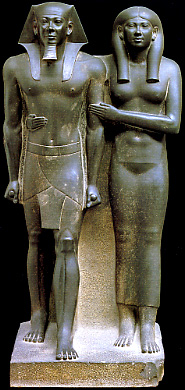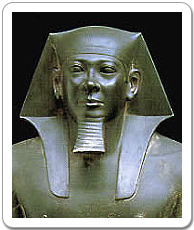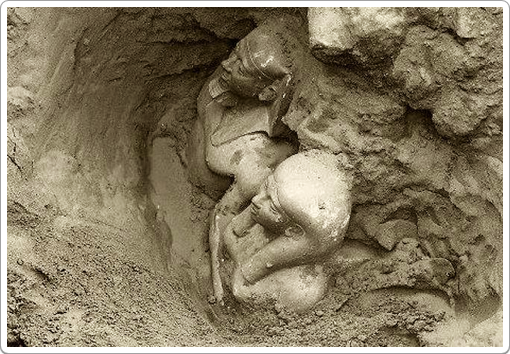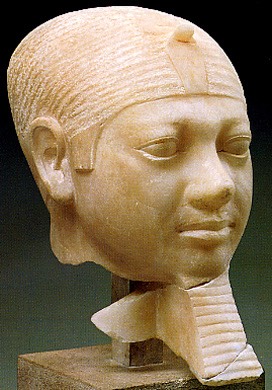
Mykerinos and Khamernebti II.
Source: Ziegler, L'art égyptien, pp. 226-227.
This group statue is truly extraordinary, not only because it has been so beautifully preserved, but even more so because it shows the king accompanied by a woman who holding him in a loving embrace.
Even though the statue does not bear any inscriptions, it is clear from the it was found during the excavations in his Valley Temple in Giza, that the king must be Mykerinos. This is confirmed by the facial similarity of this statue to other, identified statues of Mykerinos.
The woman is just slightly smaller than the king, but this is probably due to the height of the king's headdress, the nemes. She does not wear any crowns or a headdress that would identify her as a goddess, as is the case in the triad statues that were found in the Valley Temple of Mykerinos' funerary complex at Gia.
The fact that she has almost the same height as the king shows that she enjoyed a very high status.
Her loving embrace reveals an intimate relationship with the king and it can thus be concluded that she was a queen, most likely Khamernebti II.

Mykerinos is shown wearing the nemes headdress, a sign of his royalty. There is no sign of an uraeus on this statue.
The face is typical for statues representing Mykerinos, with high cheekbones, accented by the lines next to his nose, and clearly marked eyes.
His hands are clenched around what appears to be two cylinders, which may probably by stylised references to the royal sceptres.
He is shown wearing a loin cloth consisting of three parts, yet another typical element in royal iconography.His left foot is striding forward, a sign of his male vigour.

Khamernebti's face is rounder than her husband's making it somewhat more feminine. She wears a tri-partite wig, but part of her real hair is visible underneath her wig. This was a typical feature of female statues in the Old Kingdom and was intended to stress the fact that this woman could indeed afford wearing a wig. She also wears a very tight fitting dress, which is only obvious because the hem is marked just above her feet.
This statue is one of the oldest, if not the oldest, representation of a queen along her husband. It is difficult to guess why Mykerinos would have chosen to have his wife represented with him in a statue. Romantics would argue that the loving embrace shows that the king and queen loved each other dearly and that they wanted their love to live on after death. But the real reason may perhaps be of a more ritual nature: the queen was the means through which the king could procreate and thus continue his own (after)life as well.

Excavation photo of the group statue of Mykerinos and Khamernebti II.
Source: Egyptian Antiquities on Facebook
